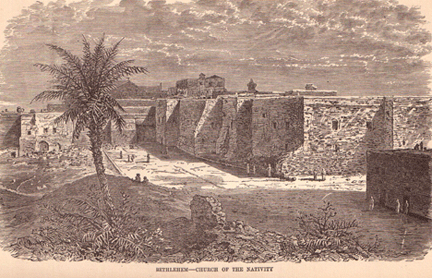
Yesterday, I began a thread on one of the numerous 19th century Bible customs travel accounts by Christian enthusiasts able to travel to their “Holy Land.†The author, Frank S. DeHass, served as the United States Consul in Palestine in the mid 19th century. His text is aptly entitled Buried Cities Recovered, or, Explorations in Bible Lands, giving the results of recent researches in the Orient, and recovery of many places in sacred and profane history long considered lost. My copy, handed down from my grandmother, was published in 1886 in Philadelphia by Bradley & Company; the tenth edition no less! This is a wonderful read and it is worth reading the entire book online, thanks to Google Books.
Bethlehem, and Hill Country of Judea
Situated on a fruitful ridge about six miles south of Jerusalem, overlooking the Valley of the Kedron on the north, and the deep chasm of the Dead Sea on the east, is Bethlehem of Judea, to the Christian the holiest place on earth.
It is one of the oldest villages in Palestine, and associated with some of the most stirring events in the religious history of the world. Here Ruth gleaned after the reapers of Boaz; here the youthful David kept his father’s flocks, and was annointed King of Israel; here, also, Jeremiah, after denouncing God’s terrible judgments upon the people, foretold the coming of “The Lord of Righteousness;” and here the shepherd’s who watched their flocks by night were startled by the angelic song announcing the Messiah’s birth, and proclaiming the evangel of “peace on earth, and good-will toward men.”
The name signifies the Hosue of Bread, and truly it may be said, Bethlehem has given to our perishing race the bread of eternal life. What countless millions have feasted on this heavenly loaf!
As we rode along the well-beaten path leading from Jerusalem, crowded with pilgrims from all lands going up to visit the place that gave birth to the Saviour of mankind, what old memories were awakened! Here, on the plain of Rephaim, over which the road winds, it is supposed the army of Sennacherib lay encamped when smitten by the destroying angel; along this same road Abraham probably journeyed on his way to the Mount of God, leading his son as a lamb to the slaughter; along the same road the Virgin and her husband once toiled on their weary way to the “City of David, which is called Bethlehem;” along the same road the magi came with their costly gifts to worship at the feet of the new-born King; and long before the advent of Christ, long before the Hebrews possessed the land, when the Jebusites still held the old “Castle of Zion,” Jacob, on his way to Hebron, traveled over this same road; and it was here that Rachel, his young and beautiful wife, died as she gave birth to her second son. How touchingly sad the narrative, “And Rachel died and was buried in the way to Ephrath, which is Bethlehem. And Jacob set a pillar upon her grave,” etc…
That the grotto pointed out as the birthplace of Christ is very near, if not the identical spot of our Saviour’s nativity, there is no reason to doubt. All tradition and history agree upon this locality. Justin Martyr, who was a native of Syria, and had every opportunity of knowing the precise place, tells us Christ was born in this cave; Origen mentions the same fact. Helena, also, before she erected her grand basilica to commemorate the event, must have known the spot. It is not likely that events so wonderful as the visit of the angels who announced his birth, the coming of the wise men from the East to render him homage, and the star standing over the place where the young child lay, would soon, if ever, be forgotten. Certainly not in the brief period that intervened between Justin Martyr and the Empress Helena.
That the present Church of the Nativity is the identical one built by this empress none will deny. It is the oldest Christian church in the world, and many of the forty-eight beautiful columns which support the cedar roof were in all probability taken from the grand Temple of Solomon on Moriah.
For fifteen centuries this venerable edifice has stood as a silent witness to the fact that in the grotto beneath its altar the “King of kings” was born, who brought “good tidings of great joy to all people;” and that also on this very site the inn of Bethlehem once stood.
to be continued tomorrow